Suppose you have the following tables, say
table: content_type
- id serial not null
- tabs json
table: data_type
- id serial not null
- html text
This is just a tiny example to illustrate.
The json stored in tabs could be like eg:
[
{
"name": "tab1",
"properties":
[{
"name": "prop1",
"order": 1,
"help_text": "help text",
"description": "description",
"data_type": 1
}]
},
{
"name": "tab2",
"properties":[{
"name": "prop2",
"order": 1,
"help_text": "help text2",
"description": "description2",
"data_type": 1
},
{
"name": "prop3",
"order": 2,
"help_text": "help text3",
"description": "description3",
"data_type": 1
}]
}
]
What I'm looking to achieve now is to make a join like the following pseudo code:
SELECT content_type.id, content_type.tabs, data_type.id, data_type.html
FROM content_type
JOIN data_type
ON data_type.id = content_type.tabs::json->'data_type'::int
Where data_type.id, data_type.html is actually joined to the tabs' properties' data_type and not as a seperate column like in the above usual join query.
Basically I'm looking for the same result as one would have if it was 2 or more tables joined together on column id's, except that one of the "tables" in this case is located inside an array of json objects.
And yes I know the above join attempt is very far off, since I want to "add/append" the additional attributes to a modified version of the tabs json column, not as additional seperate columns.
In this case the join would return - in the select/join query - the id inside the tabs json array and extend it with the join-fetched additional attributes, so instead of simply a "data_type": 1 it would return something like:
"data_type": {
"id":1,
"html": "<input type='text' id='%v' class='%v' placeholder='%v' value='%v' ng-model='%v'>"
}
... and additional attributes of course. This is just a simple example to illustrate the problem.
[
{
"name": "tab1",
"properties":
[{
"name": "prop1",
"order": 1,
"help_text": "help text",
"description": "description",
"data_type": {
"id":1,
"html": "<input type='text' id='%v' class='%v' placeholder='%v' value='%v' ng-model='%v'>"
... and of course additional columns fetched from the data_type table, and added to the select return in our join, to manipulate the original json array of tabs->properties->data_type
}
}]
},
{
"name": "tab2",
"properties":[{
"name": "prop2",
"order": 1... etc
Hope this makes sense and that you can help me with this, because I seem to be somewhat stuck.
Ps. Using the latest 9.4beta3 btw.
I found a link here that give me hopes that this is indeed possible to achieve with PostgreSQL: http://www.slideshare.net/EnterpriseDB/no-37327319 (see slide 17)
Other links that might be helpful:
- http://michael.otacoo.com/postgresql-2/manipulating-jsonb-data-with-key-unique/
- http://hashrocket.com/blog/posts/faster-json-generation-with-postgresql
- PostgreSQL 9.2 row_to_json() with nested joins
- http://info.enterprisedb.com/rs/enterprisedb/images/EDB_White_Paper_Using_the_NoSQL_Features_in_Postgres.pdf (page 13)
I tried experimenting a bit - here's what I have so far:
SELECT content_type.id, content_type.tabs as original, gf.json_agg as new_tabs
FROM content_type,
LATERAL (
select json_agg(row1) from((
select y.name, ss.extended_properties
from json_to_recordset(
(
select *
from json_to_recordset(
(
SELECT json_agg(ggg)
from(
SELECT tabs
FROM
(
SELECT
*
FROM content_type as ct
WHERE ct.id=content_type.id
) dsfds
)ggg
)
) as x(tabs json)
)
) as y(name text, properties json),
LATERAL (
select json_agg(row) as extended_properties
from(
select name, "order", data_type, data_type.html as data_type_html, help_text, description
from json_to_recordset(properties)
as k(name text, "order" int, data_type int, help_text text, description text)
JOIN data_type
ON data_type.id = k.data_type
)row
) ss
))row1
) gf
which results in the following (zoom in in your browser to read the text in the image - hold ctrl + mwheel up og plus key on keyboard):

At least now I can put in the data_type.html in there, although I would have preferred "data_type": { "id": 1, "html": "[somehtmlhere]"}
For some reason it wont allow me to wrap json_agg around it and show you the output as 1 combined json document. Don't udnerstand why, but guess it has to do with LATERAL and it probably is a bug in PostgreSQL 9.4 beta3
I know there must be a way better approach and solution to this - I'm not very experienced with pgSQL or pg in general... yet.